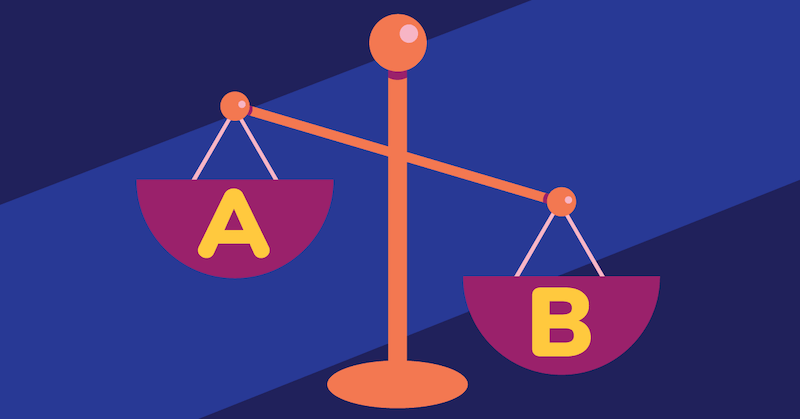What is A/B Testing?

Intuition can be a great starting point in the early stages of putting together a marketing plan – after all, you have to start somewhere! But while intuition is great, data is better. Running A/B testing can help you make sure that you spend your marketing dollars wisely. Over time, you can zero in on exactly what will resonate with your target audience and move them to action. So, what is A/B testing?
What is it?
Put simply, “A” and “B” are two groups that you run simultaneously for a set span of time and compare the results to see which was more effective. Usually, the “A” is the control group (the original, unchanged variable) and “B” is the changed or updated group. (You can test more than one variable at a time, but then it’s not really an A/B test – it becomes a multivariate test. There’s a time and place for that, but for now, we’ll focus on A/B testing.)
The idea of A/B testing dates back at least 100 years, but it may be even more relevant in the digital age. Some examples of variables that can be tested in a marketing A/B test are:
-
Calls to action (CTAs)
-
Ad design
-
Landing page
-
Ad copy or messaging
-
Color scheme
Basically, if it’s a changeable part of an ad campaign, you can run A/B testing on it! It’s a simple concept, but it can provide you with extremely valuable information for your marketing. Here are just a few reasons why you may want to consider running an A/B test.
Benefits of A/B Testing
Improve user experience
Running an A/B test can uncover weaknesses in your campaign. Let’s say you test your current landing page with a contact form at the bottom, against a new page that has a floating contact form sidebar. If you find you get double the form fills from the new page, that’s a good clue that poor user experience was making your audience leave before they could fill out the form. A/B testing is a great way to discover issues like these. This helps you improve the experience your audience has while viewing your ad or visiting your site. Better experience often leads to more conversions.

Increase ROI
Very little in marketing is completely free. Running an A/B test is no exception. However, the upfront cost of a test could lead to a higher return on investment in the long run. Every test you run will give you helpful information that you can use to fortify your current campaign or plan your next one. Over time, you can tailor your marketing to zero in on only the strategies that work, trimming those that don’t. That will lead to long-term savings.
Gain confidence in changes
Making a change to your marketing can be intimidating if you’re only relying on your intuition. Sure, you might think a particular change will lead to improvement – but you never really know until you try! A/B tests provide a low-stakes environment where you can test out a change before committing to it fully. The best part is that you win either way. If your “B” group falters, you know that you were on the right track with your “A” group. If your “B” group blows “A” out of the water, you can feel confident in making the switch.
When not to run A/B testing
Of course, A/B tests aren’t right for every single situation. If you’re just looking to make a very simple change that won’t cost you much, it may be worth just making the change. The same goes for updating your creatives to follow best practices. (If your ads don’t have a CTA, and you want to add one, there’s no need to wait for test results!) Some changes simply aren’t worth the extra cost of a test. If you’re testing a creative design where your “A” group photo is zoomed in 10% more than your “B” group, the difference between the two probably isn’t big enough to justify a test. (However, it may be worth testing whether full-body photos work better than closeups of people’s faces, for example.)
Other scenarios when an A/B test might not be right for you are if you’re working within an extremely tight budget or if you’re just getting started and don’t have a good idea of who your audience is. If your ads are only being seen by a handful of people, or you’re still trying to determine who you’re trying to reach, your results could wind up very skewed. If your audience is too small to give you statistically significant results, your budget would be better spent on trying to grow your audience first.
However, if your audience is established, and you have a healthy budget and some ideas, it is well worth considering adding an A/B test to your marketing plan.
But what about the cost?
We can’t talk about A/B testing without talking about the elephant in the room: the cost. Cost is the #1 issue that scares away people from trying an A/B test. And we get it! It can feel scary to know that you’ll need to spend more upfront. You have to start the campaign with two versions of whatever you’re testing, whether that is an ad or a landing page. That isn’t free. On top of that, you can’t just show your work to a few people. You have to run a robust enough campaign so that you can get useful data. Of course there is a cost associated with that.
But consider the alternative: not testing your work. If you run your campaigns based on pure intuition, or even based on what has worked decently for you in the past, you could be missing out and never know it. Maybe your old landing pages got you a few conversions. Don’t you want to see if you can grow that number? Or maybe you are getting ready to launch your new branding. Isn’t it worth making sure that your audience likes it before you spend the money to change your entire website? If a change – small or significant – could potentially give your brand a huge boost, you owe it to your business to at least try it out. If your main question is “what about the cost,” what if you reframed it as “what about the potential gains”?
There’s no doubt that running an A/B test will cost you a little upfront. But the savings in the long term could be huge. Running an A/B test can give you the signal that your new idea is a winner – or, just as useful, it can stop you from making a change that doesn’t resonate with your audience. Either way, once the test is over, you can feel confident that you’re making the right choice, whether that means sticking with the old way or trying something new.
Running A/B tests can work wonders for your brand, but it works best if you have a trusted partner by your side. MPP is standing by and ready to help you navigate the challenges!


